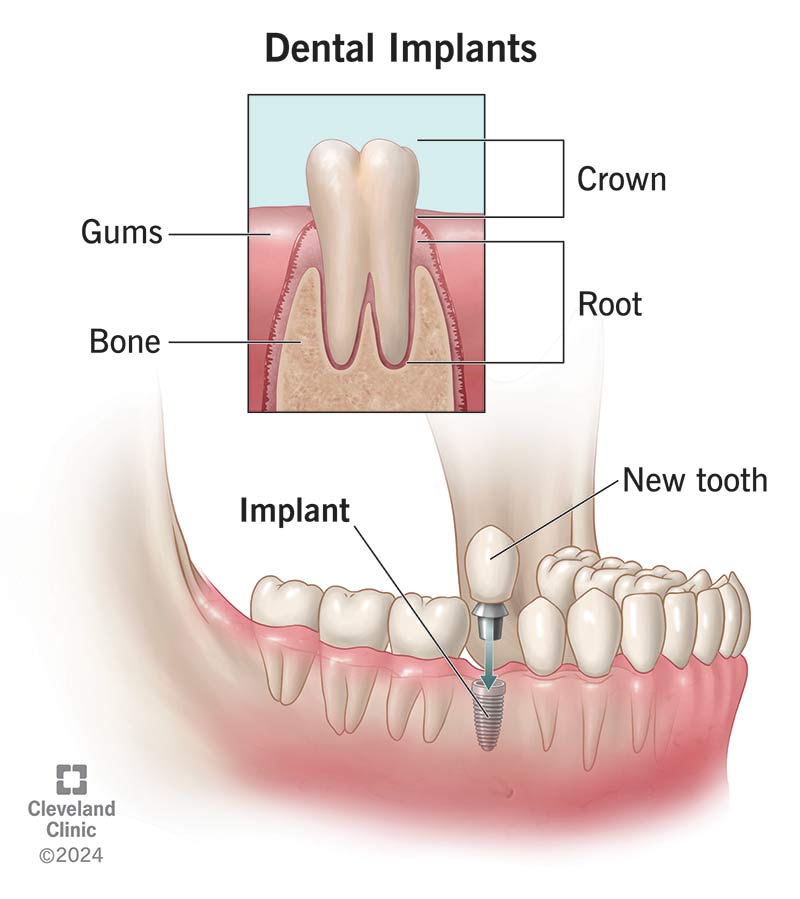The 45-Second Trick For Dental Implants
The 45-Second Trick For Dental Implants
Blog Article
The Facts About Dental Implants Revealed
Table of ContentsThe Greatest Guide To Dental ImplantsIndicators on Dental Implants You Should Know4 Easy Facts About Dental Implants Shown8 Easy Facts About Dental Implants Shown
are medical gadgets operatively dental implanted right into the jaw to bring back an individual's capability to chew or their look. They give support for man-made (fake) teeth, such as crowns, bridges, or dentures. When a tooth is shed because of injury or disease, a person can experience complications such as quick bone loss, faulty speech, or changes to eating patterns that cause pain.
Structure of The Dental Implant System picking oral implants, speak to your dental provider regarding the potential benefits and dangers, and whether you are a prospect for the treatment. Things to consider: Your total health and wellness is an important consider determining whether you are a great candidate for dental implants, exactly how long it will take to heal, and just how long the dental implant may stay in area.
Smoking cigarettes might impact the healing procedure and reduce the lasting success of the implant. The recovery process for the implant body might take several months or longer, throughout which time you commonly have a temporary abutment in place of the tooth. the oral implant treatment: Carefully follow the oral hygiene guidelines provided to you by your dental service provider.
Dental Implants Things To Know Before You Get This
Implant failure can cause the requirement for one more procedure to repair or change the dental implant system. Restores the capacity to eat Restores aesthetic appearance Helps keep the jawbone from diminishing due to bone loss Protects the wellness of the surrounding bone and gum tissues Aids maintain adjacent (nearby) teeth secure Enhances top quality of life Damages to surrounding natural teeth during implant positioning Injury to the surrounding tissues throughout surgical procedure, such as sinus opening Injury throughout surgery (as an example, fracture of surrounding jawbone) Insufficient feature, such as seeming like the teeth do not attack together generally A sensation that the tooth hangs or turning in position arising from a joint screw loosening up Implant body failing (looseness of the dental implant body) due to systemic infection, which may be more probable in individuals with unchecked diabetes mellitus because of neighborhood infection in bone and gum tissues sustaining the dental implant body because of delayed healing, which may be more probable in individuals that smoke Problem cleaning up the gums around the dental implant, resulting in inadequate oral health Untreated periodontal disease Post-surgical pins and needles due to nerve impingement or damage Constantly alert health and wellness treatment companies and imaging specialists that you have dental implants before any kind of magnetic vibration imaging (MRI) or x-ray procedures.
FDA is not knowledgeable about any type of unfavorable events reported for MRI or x-ray treatments with oral implants. Dental discover here implants systems are usually constructed from materials that comply with global agreement requirements of the International Company for Standardization (ISO) or ASTM International. These requirements have details of what makes a secure product.
Various other materials such as gold alloys, cobalt-based alloys, titanium alloys, or ceramic materials are often used. The safety profiles of these materials are widely known. Oral implant systems are assessed according to worldwide consensus standards. Biocompatibility testing, to show that physical call with the device does not cause difficulties like irritation or sensitive reaction, becomes part of the evaluation that helps guarantee the products in the dental implant system are secure and do not trigger damaging impacts when dental implanted in individuals.

Examine This Report on Dental Implants
Some people are not qualified for dental implant surgical procedure. It is for dental surgeons to operate individuals with: intense illnessuncontrollable metabolic diseasebone or soft cells condition or infectionIf these problems are settled, a person can have the surgical treatment. Dental Implants. In, oral specialists avoid operating people with: If people with any one of the above undergo oral implant surgical treatment, there is a greater threat of the implant falling short
Some people have a jawbone problem that prevents adequate bone for a dental implant from developing. The surgeon will after that use a bone or bone substitute to repair and build up the area.
Dental implant surgery is an individualized procedure. It's not the same for everybody. However the following gives a basic review of what you can best site anticipate your dental practitioner, dental surgeon, periodontist or prosthodontist to do: Position the implant surgically. Offer visit the site you time to recover. Attach the post and final crown, bridge or denture.
Next, your doctor will meticulously put the dental implant right into your jaw. Lastly, your surgeon will rearrange your periodontals and shut the cut with stitches. If your dental implant is near the front of your mouth, your dentist will certainly make a short-term tooth for you to use until you heal. By doing this, you will not have a gap in your smile while you recover.
All about Dental Implants
Your service provider can inform you what to anticipate in your circumstance. During the recovery phase, your jawbone ought to fuse to the oral implant. This procedure, called osseointegration, is important for security and long-term success. This procedure can take anywhere from 3 to nine months. Sometimes, it may take much longer.
Once your dental implant heals, your dentist can affix the abutment (small connector message) and your final restoration (crown, bridge or denture). This typically takes about one hour to finish and may need a 2nd minor surgical treatment. You shouldn't really feel any discomfort during your oral implant procedure due to the fact that your supplier will certainly use medication to numb your gum tissues.
Report this page